I missed the bird the first time. That, in and of itself, is not unusual when chasing birds. This is especially true for me, a card-carrying member of the Dipper’s Club and recipient of that organization’s less than prestigious Lifetime Achievement Award for my strong work missing a staked out Black-headed Gull on six separate occasions. But there was something different about this individual, this Connecticut Warbler, that made that miss all the more frustrating.
For starters, while there are some places on this continent where one can trip over singing Connecticut Warblers and have to shovel them out of the way of oncoming traffic for their own safety, but across much of the rest of the continent this skulkis maximus is a very desirable bird indeed. This is especially true in the southeastern United States, which has the unfortunate distinction of lying between the two lines of the Connecticut’s migratory triangle. In the spring it hops over the Caribbean to Florida before hanging a left and running up the Mississippi flyway, making time like it’s late for a hot date (which it is in a manner of speaking). In the fall it generally follows the coast to Maryland or so, before jumping off for South America in one truly epic flight. My little corner of the world lies between the two extremes, and Connecticut Warbler has been little more than the whisper of a ghost around here.
Even more, during both journeys the species famously keeps a low profile. So an individual, even if it were present, is not a bird you would easily see without a bit of luck. Add to this reputation for difficulty the fact that local birder after local birder traveled to the spot where I had missed the bird and found it with an ease that turned my stomach and you can see why this particular dip had the makings of a foundation on which I could build a skyscraper of avian-induced neuroses. So when I did find the bird a few days later, after it had stayed a staggering 9 days in one spot, the fact that I could put the dipper’s curse to rest was only the second most interesting thing about this bird.
Migrants, even the slow motion fall return south, generally don’t stick around longer than a few days. A study published in the journal Bird-banding in October of 1939 titled The length of stay in Migratory Birds in Southeastern Pennsylvania (.pdf) suggests that warblers in general stay in one place an average of 4 and a half days before moving on. But this is not really common knowledge among most birders. How many of us can corroborate that number, especially when most of us are lucky to get out in the field one or two times a week? And how often do we even note individual southbound migrants anyway, when the waves of Redstarts and Cape Mays and Palms come roaring out of the boreal forests every year? Not often, I’d wager. Birds are generally off our radar as individuals, we count in dozens and bushels and flocks. I certainly never really considered how migration works on an individual scale before this one extraordinary bird made the question manifest in my own mind.
It makes some sense though. So long as a bird has cover and food, why wouldn’t it stick around as long as it could? Migration is dangerous business after all, and a cozy willow grove with plenty of caterpillars around certainly seems like a fine enough place to spend some time, especially if the weather sacks it in a little bit. More so if you’re a first year bird like this one appeared to be, pulled by instinct alone towards a patch of rainforest you’ve never seen.
That might explain an extra day or two, but this bird managed to stick it out through at least two major weather systems. While the Palm Warblers with which it had been loosely associating took off just ahead of a cold front early on, the Connecticut stuck it out through the wind and rain for an additional 8 days. I don’t know what the record is for long staying migrants but this bird was pushing it, and the remarkable thing is that no one would have even known considered the novelty of its endurance if it hadn’t been anything other than the skulking and mysterious Oporornis agilis.
In the end, the Connecticut was last seen on the 20th, a full 13 days after it had been first reported. The night it left the moon was two days shy of full, the sky was cloudless, and there was a steady northwesterly breeze in the air. The conditions couldn’t have been better for migration if they had been ordered out of a catalog. Even this bird, with such a preternatural fondness for its willow grove on a far arm of a reservoir in Durham County, NC, couldn’t fight such perfect flying weather, and it was gone the next morning.
While it was here, however, tons of local birders, and many from farther away, came to see it. For many, as it was for me, it was a life bird. For some it was the culmination of years of searching. For all it was a well enjoyed moment with one of the more alluring species of a particularly alluring family. But because of the strange circumstances of its appearance it was also more; a reminder of the way the movement of birds can captivate and amaze us. As if we needed another reason, right?


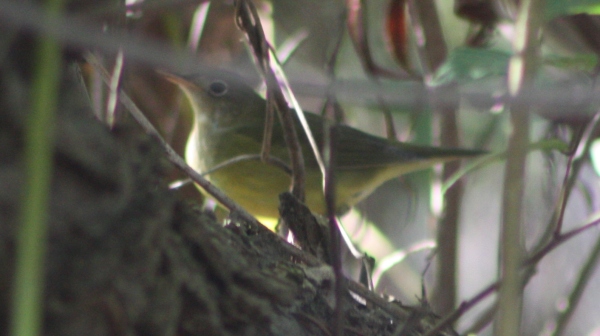



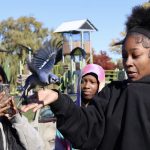


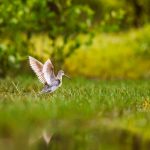
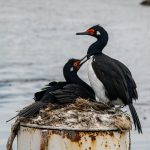
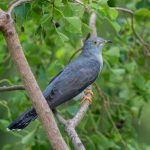
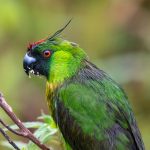
Fascinating!
nice post.
Interesting article for me, because this is my absolute “nemesis” bird. I live in Florida from November through May, and in Connecticut the rest of the year. A few Connecticut Warblers are sen in south Florida each year between May 10 and May 14, give or take a day or two. I have managed to miss them every year so far, despite looking. Two years ago I was at a county park, and a Connecticut was walking around on a lawn in full view less than half a mile away all afternoon, but I didn’t find out about it until the following day. I finally did see one in Minnesota this past summer, but I was in a group and missed the photo because there were people standing on both sides of me and they would not permit me to move to get the right angle through the branches. I plan to travel back to that very spot again and spend two days there if necessary just to get some photos of this species.
I am curious as to where in North America you believe Connecticut Warblers to be so plentiful that you can run them over?
John Schwarz
http://www.birdspix.com
I don’t know Nate. You writing about a Connecticut Warbler sure seems like you are stepping on Christopher’s toes when you consider that his is the New England Beat. 🙂
Great post anyway…
@Robert, jmj- Thanks!
@Corey- I considered that. Just for this, I’ll allow Christopher to write one post on Carolina Wrens at a time of his choosing.
Great post – looking forward to one on Carolina Wrens now 🙂
@John- I can certainly sympathize with your Connecticut frustrations!
And I admit I used a bit of hyperbole in describing the abundance of Connecticut Warblers in some parts of the continent, they’re not common anywhere in their range. But I’ve always heard they’re easiest to find in boreal Canada where they nest where, it should be said, the roads are also rather narrow.
@Charlie- I guess I should start writing about my common birds rather than my weird ones, huh?
Don’t listen to these guys Nate. After all, you saw the bird in North Carolina! Plus, we all feel sorry for you being the Big Dipper and all. Thank goodness that curse is broken.
I like the photo too. It really shows how tough it is to see that Connecticut Warbler.